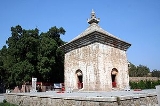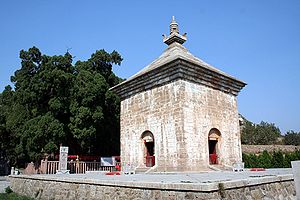
Four Gates Pagoda
Encyclopedia

Sui Dynasty
The Sui Dynasty was a powerful, but short-lived Imperial Chinese dynasty. Preceded by the Southern and Northern Dynasties, it ended nearly four centuries of division between rival regimes. It was followed by the Tang Dynasty....
(581-618 AD) stone Chinese pagoda
Chinese pagoda
Chinese Pagodas are a traditional part of Chinese architecture. In addition to religious use, since ancient times Chinese pagodas have been praised for the spectacular views which they offer, and many famous poems in Chinese history attest to the joy of scaling pagodas.-History:The pagoda is...
located in central Shandong
Shandong
' is a Province located on the eastern coast of the People's Republic of China. Shandong has played a major role in Chinese history from the beginning of Chinese civilization along the lower reaches of the Yellow River and served as a pivotal cultural and religious site for Taoism, Chinese...
Province, China
China
Chinese civilization may refer to:* China for more general discussion of the country.* Chinese culture* Greater China, the transnational community of ethnic Chinese.* History of China* Sinosphere, the area historically affected by Chinese culture...
. It is thought to be the oldest remaining pavilion-style stone pagoda
Pagoda
A pagoda is the general term in the English language for a tiered tower with multiple eaves common in Nepal, India, China, Japan, Korea, Vietnam and other parts of Asia. Some pagodas are used as Taoist houses of worship. Most pagodas were built to have a religious function, most commonly Buddhist,...
in China. The oldest extant brick-built pagoda in China is the 40 metres (131.2 ft) Songyue Pagoda
Songyue Pagoda
The Songyue Pagoda , constructed in 523 AD, is located at the Songyue Monastery on Mount Song, in Henan province, China. Built during the Northern Wei Dynasty, this pagoda is one of the few intact sixth-century pagodas in China and is also the earliest known Chinese brick pagoda...
of 523 AD.
Location
The Four Gates Pagoda is located at the foot of Qinglong Mountain, near Liubu Village, in Licheng DistrictLicheng District
Licheng is a district in Quanzhou Municipality, FJ.-Cultural Attractions:*Kaiyuan Temple *Qingjing Mosque - 1000 years old in 2009-Administration:The district comprises eight Street Offices :* Jiangnan * Fuqiao...
, under the administration of Jinan
Jinan
Jinan is the capital of Shandong province in Eastern China. The area of present-day Jinan has played an important role in the history of the region from the earliest beginnings of civilisation and has evolved into a major national administrative, economic, and transportation hub...
City, about 33 kilometers southeast of the city of Jinan proper. The pagoda is located to the east of the site of the Shentong Temple , which was one of the most important temples in northern China at the time the pagoda was built but is now in ruins.
According to an inscription on a stone tablet which was discovered inside the pagodas ceiling in 1972, the pagoda was "built in the seventh year of the Daye
Emperor Yang of Sui
Emperor Yang of Sui , personal name Yang Guang , alternative name Ying , nickname Amo , known as Emperor Ming during the brief reign of his grandson Yang Tong), was the second son of Emperor Wen of Sui, and the second emperor of China's Sui Dynasty.Emperor Yang's original name was Yang Ying, but...
period of the Sui Dynasty". This corresponds to the year 611 AD, near the end of the dynasty. During the Sui Dynasty, stone and brick were introduced as material for building pagodas. The Four-Gates Pagoda was built from blocks quarried from a hard local rock. All extant older stone pagodas are sculptured pagodas or columns in the shape of a pagoda. The simple design of the Four Gates Pagoda is typical for one-storey, pavilion-style pagodas: It has a square cross-section delineated by plane side walls. All elements of the structure are symmetrical with four identical sides each facing one of the four cardinal directions. In the center of each wall is a door with straight sides and round arch on top (hence the name). The roof of the pagoda is pyramid shaped. It consists of 23 tiers of overlapping stone slabs and is supported by 5 tiers of stone eaves. The tip of the roof is occupied by a stone steeple. The overall shape of the steeple resembles a box-shaped pagoda which is carved with Buddhist
Buddhism
Buddhism is a religion and philosophy encompassing a variety of traditions, beliefs and practices, largely based on teachings attributed to Siddhartha Gautama, commonly known as the Buddha . The Buddha lived and taught in the northeastern Indian subcontinent some time between the 6th and 4th...
scriptures and sits on its own Sumeru pedestal with stone corner decorations in the shape of banana leaves. The spire of the steeple is made up of 5 stone discs. The total height of the pagoda is 10.4 meters; each side is 7.4 meters long.

Buddharupa
Buddharūpa is the Sanskrit and Pali term used in Buddhism for statues or models of the Buddha.-Commonalities:...
sculpture is located. The four sculptures are: the "Subtle-voiced" Buddha on the northern wall, the Ratnasambhava
Ratnasambhava
Ratnasambhava is one of the Five Dhyani Buddhas of Vajrayana or Tantric Buddhism. Ratnasambhava's mandalas and mantras focus on developing equanimity and equality and, in Vajrayana buddhist thought is associated with the attempt to destroy greed and pride. His consort is Lochana and his mount is a...
Buddha on the southern wall, the Akshobhya
Akshobhya
In Vajrayana Buddhism, Akṣobhya is one of the Five Wisdom Buddhas, a product of the Adibuddha, who represents consciousness as an aspect of reality...
Buddha on the eastern wall, and the Amitābha
Amitabha
Amitābha is a celestial buddha described in the scriptures of the Mahāyāna school of Buddhism...
Buddha on the western wall. On the base of the statues is a dedication inscription dated to the year 544 AD (during the times of the Eastern Wei Dynasty). According to the inscription, a high-ranking military and civil official named Yang Xian Zhou commissioned the Buddha statues to commemorate his ancestors on occasion of the anniversary of his father's death. This suggests that the statues are significantly older than the pagoda which houses them. The pagoda may thus have been built for the purpose of housing these sculptures.
The head of one of the four Buddha statues in the pagoda, the Akshobhya Buddha seated on the east wall, was sawed off and stolen in 1997. The head came eventually into the possession of a group of business people from Taiwan, who presented it to Dharma Drum Mountain Foundation in Peitou, Taipei
Taipei
Taipei City is the capital of the Republic of China and the central city of the largest metropolitan area of Taiwan. Situated at the northern tip of the island, Taipei is located on the Tamsui River, and is about 25 km southwest of Keelung, its port on the Pacific Ocean...
, to be exhibited in the foundation's Museum of Buddhist History and Culture. After the origin of the head was determined, it was returned to its original location in 2002.
Next to the pagoda stands an ancient pine tree known as the "Nine-tip Pine" or "Thousand Year Pine" since it is believed to be more than thousand years old. Two other pagodas dating from the Tang Dynasty
Tang Dynasty
The Tang Dynasty was an imperial dynasty of China preceded by the Sui Dynasty and followed by the Five Dynasties and Ten Kingdoms Period. It was founded by the Li family, who seized power during the decline and collapse of the Sui Empire...
stand near the Four-Gates Pagoda: The Dragon-and-Tiger Pagoda
Dragon-and-Tiger Pagoda
The Dragon-and-Tiger Pagoda is a Tang Dynasty brick and stone pagoda located in central Shandong Province, China. It is considered a characteristic example of the pagoda style of the period.- Location :...
and the Minor Dragon-and-Tiger Pagoda.
See also
- Dragon-and-Tiger PagodaDragon-and-Tiger PagodaThe Dragon-and-Tiger Pagoda is a Tang Dynasty brick and stone pagoda located in central Shandong Province, China. It is considered a characteristic example of the pagoda style of the period.- Location :...
- Thousand-Buddha CliffThousand-Buddha CliffThe Thousand-Buddha Cliff is historical site of mostly Tang Dynasty rock carvings in central Shandong Province, China. Along a cliff face of 63 meters length, over 210 statues and 43 inscriptions have been reported...
- Nine Pinnacle PagodaNine Pinnacle PagodaThe Nine Pinnacle Pagoda or Jiuding Pagoda is an 8th century pavilion-style brick pagoda located in central Shandong Province, China. It is noted for its unique roof design featuring nine small pagodas.-Location:...
- List of sites in Jinan
- Chinese pagodaChinese pagodaChinese Pagodas are a traditional part of Chinese architecture. In addition to religious use, since ancient times Chinese pagodas have been praised for the spectacular views which they offer, and many famous poems in Chinese history attest to the joy of scaling pagodas.-History:The pagoda is...

